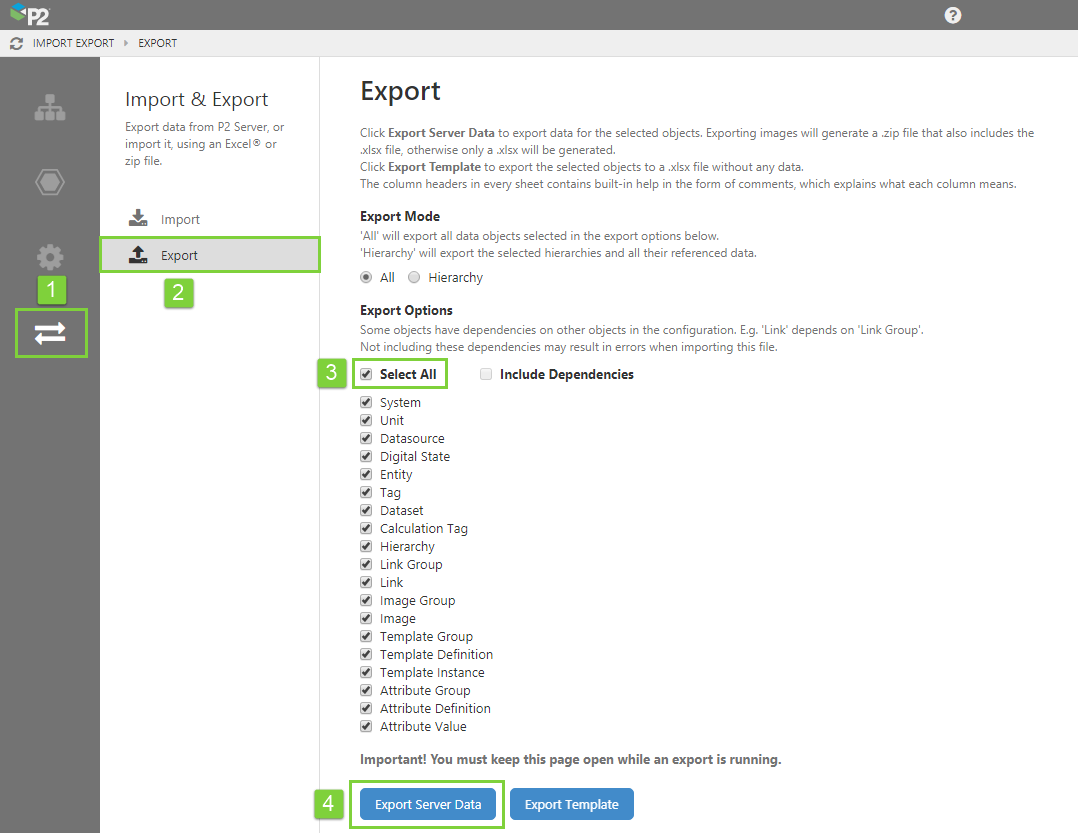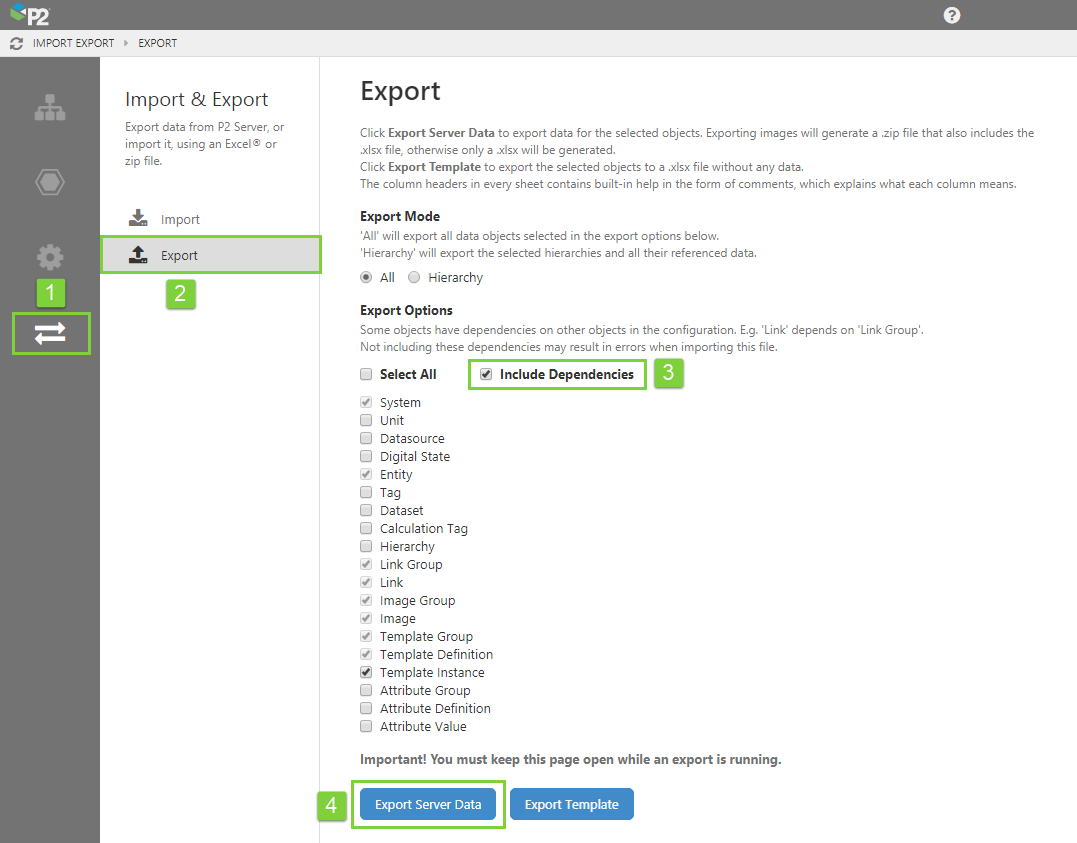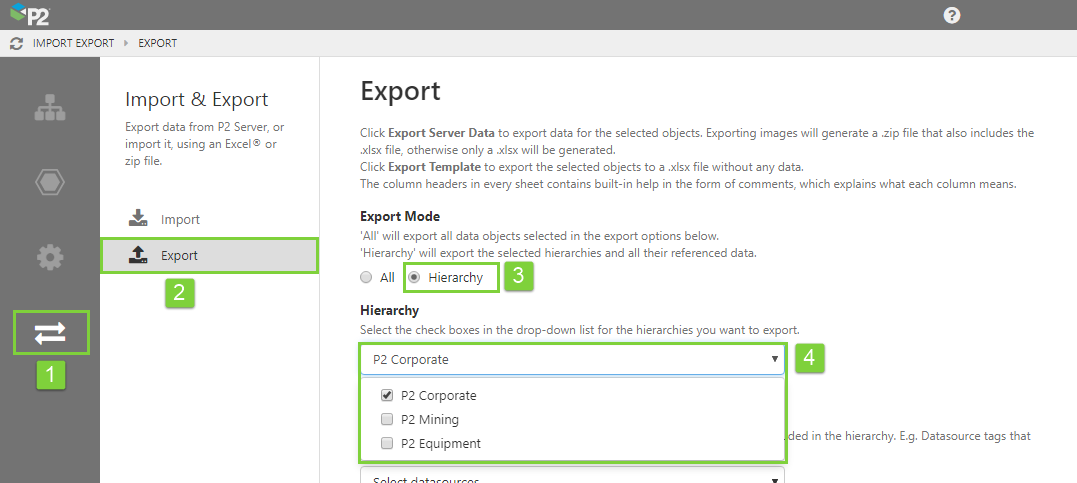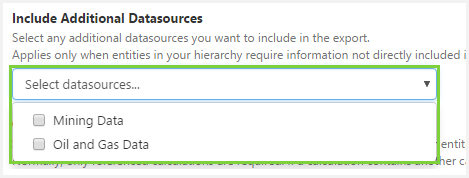ON THIS PAGE:
P2 Server Management allows you to export all the data in the P2 Server database to an Excel® spreadsheet. The main reason for doing this is so you can more easily update the configuration in bulk. It also allows you to download a blank template, useful for when you are initially setting up your configuration.
Contents of the Export File
Depending on what objects you choose to export, the export file will either be a .zip file or an .xslx file.
Excel File
You will export an .xslx file if your exported configuration does not contain images, or if you export the template.
Zip File
You will export a .zip file if your exported configuration contains images. Your zip file will contain the .xslx configuration file as well as a folder containing the images. Images are organised by image group.
Exporting The Whole Configuration
Exporting the entire configuration is simple.
- In P2 Server Management, click the Import/Export
 icon in the navigation bar.
icon in the navigation bar. - Select the Export
 option from the middle panel.
option from the middle panel. - From the Export Options, choose Select All.
- Click the Export Server Data button.
The 'Save As' dialog box opens and you will be prompted to save the zip file to your computer.
During export, you can see its progress in the download status bar at the bottom of your screen.
Note that in the .xslx file, the Global Id column has been filled in for all tabs, for existing entries only. This is the GUID that corresponds directly to the records in the database, and is the field that allows the database to be updated by re-importing this spreadsheet. A Global ID will be created automatically for any new entries.
Exporting Part of The Configuration
You can export a spreadsheet that contains only selected objects. You should do this if you only need to update part of your configuration. Your exported file will contain only the configuration tabs for the selected objects.
When updating your configuration, you should be aware that dependencies may exist for the configuration you wish to update. A dependency exists if the selected object requires information from another object. For example, if you want to only update links, a dependency exists between links and link groups. Be especially careful when updating attribute values and tags, as these objects have many dependencies.
- In P2 Server Management, click the Import/Export icon in the navigation bar.
- Select the Export option from the middle panel.
- De-select Select All, and select Include Dependencies. Then select the objects you want to export. As you select an object, other objects will also be selected if your selected object has a dependency.
Note: You may elect to not include dependencies by using Select All and unselecting the objects you do not want to export. Use this with caution. If you attempt to import a spreadsheet in which the dependencies are not resolved, the import of the relevant sheets may fail. - Click the Export Server Data button.
Save the file to your computer, and edit as required before importing.
Remember to ensure that the Global Id column is retained for all tabs, for existing entries only. This is the GUID that corresponds directly to the records in the database, and is the field that allows the database to be updated by re-importing this spreadsheet. A Global ID will be created automatically for any new entries.
Exporting Selected Hierarchies
You can export a spreadsheet that contains only selected hierarchies, and their associated objects. You should do this if you only need to update some hierarchies in your configuration.
Your exported file will contain all of the configuration tabs, but only the configuration associated with the selected hierarchies will be exported.
When updating your configuration, you should be aware that dependencies may exist for the configuration you wish to update. A dependency exists if the selected object requires information from another object. Be especially careful when updating attribute values, as this object has many dependencies.
1. In P2 Server Management, click the Import/Export icon in the navigation bar.
2. Select the Export option from the middle panel.
3. For the Export Mode, select Hierarchy.
4. From the Hierarchy drop-down list, select the check boxes for the hierarchies you want to export.
5. If your hierarchy requires additional configuration that is not directly included in the hierarchy, you should select the datasources containing the additional configuration. For example, some of the calculations assigned to attribute values for entities in your hierarchy may reference tags from other datasources that would not normally be included in the export.
6. If you want to export all images within a group, and not just those referenced in the hierarchy, you should select the image groups you want to include in the export.
7. If your hierarchy contains calculations assigned to attribute values for entities, and those calculations contain additional calculations that are not included in the hierarchy, you will need to export all calculations in the system.
8. When you have finished selecting your options, click the Export Server Data button at the bottom of the page.
Save the file to your computer, and edit as required before importing.
Remember to ensure that the Global Id column is retained for all tabs, for existing entries only. This is the GUID that corresponds directly to the records in the database, and is the field that allows the database to be updated by re-importing this spreadsheet. A Global ID will be created automatically for any new entries. Object dependencies must also be maintained.
Exporting a Template
You can download a blank version of the spreadsheet that has the same tabs and column headings, but does not contain any data. You should use this if you are importing configuration into a fresh database.
- In P2 Server Management, click the Import/Export icon in the navigation bar.
- Select the Export option from the middle panel, and choose Select All, or choose individual objects as required.
- Click the Export Template button.
Save the file to your computer, and edit as required before importing.
Release History
- Exporting Your Configuration 4.5.1 (this release)
- Added ability to export images
- Exporting Your Configuration 4.5.0
- Allow users to export selected hierarchies
- Exporting Your Configuration 4.4.5
- Allow users to export selected objects
- Exporting Your Configuration 4.3










